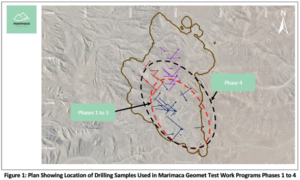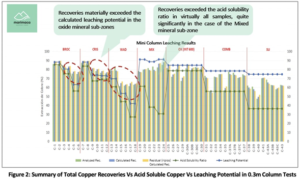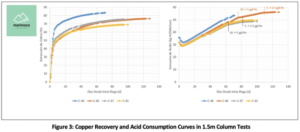Phase 4 Metallurgical Testing Confirms Recovery Assumptions and Identifies Areas for Optimization and Improvement
septiembre 8, 2020
Vancouver, British Columbia, September 08, 2020 – Marimaca Copper Corp. (“Marimaca Copper” or the “Company”) (TSX: MARI) is pleased to announce the results of the phase 4 metallurgical testing program (“the Program”) for the Company’s flagship Marimaca Copper Project (“Marimaca” or “the Project”), located in northern Chile.
The results confirm the recovery assumptions made in the recently released PEA (refer to announcement on 4 August 2020), which projected Marimaca to have industry leading pre-production capital costs and bottom quartile all in sustaining cash costs, delivering compelling economics including a post tax NPV8 of US$524m and an IRR of 33.5% at a US$3.15/lb copper price.
Highlights
- Comprehensive metallurgical testing program completed comprising composite samples from all defined mineral sub-zones at Marimaca
- Builds upon results from Phases 1,2 and 3 testing and broadened sampling across the deposit
- Provides a comprehensive assessment of variability across the deposit
- Testing covered multiple items including mini-columns and 1.5m columns to give strong indication of eventual heap leach recoveries
- Results confirm the recovery assumptions made in the PEA
- Average life of mine recovery estimated to be 75.7% of total copper for heap leach and 40% for dump leach
- Recoveries exceeded acid soluble component of total copper in virtually all samples, some by significant margins, indicating a larger proportion of the copper is acid soluble and will be recovered in heap leaching
- Seawater confirmed to be compatible with heap leaching process with no reduction in recovery and some increases in recovery noted in certain mineral sub-zones
- Multiple areas identified for optimization work to further improve economics of Marimaca
- Phase 5 program planned to address final metallurgical aspects ahead of a Preliminary Feasibility Study and optimize operating parameters for the Project
Luis Tondo, CEO of Marimaca Copper commented:
““We are extremely pleased with the results of the Phase 4 metallurgical program, which confirm the important assumptions we have made in the PEA with respect to copper recovery at Marimaca. As in the first three phases, recoveries exceeded acid solubility ratios for virtually all samples. It was a particularly positive surprise that, in several cases, the recoveries exceeded the calculated maximum expected recovery (leaching potential) of the sample material. This is attributed to the presence of black copper oxide species, which have strong leaching profiles but did not report to the soluble copper assays. This provides us with a high level of confidence in our ability to achieve the recovery assumptions applied in the PEA.
This is a significant de-risking milestone as we continue to move Marimaca towards future development and we are now planning for the next phase of studies, which we hope to commence before the end of 2020. In addition, we are continuing with our extensive exploration program to test the exciting potential in the Marimaca district.”
Overview of Metallurgical Test Work Programs Completed
METALLURGICAL TESTING PHASE 4
The Phase 4 metallurgical test work program, which commenced in September 2019, builds upon the results received in Phases 1, 2 and 3 testing programs. This phase was designed to be broader in its coverage of the metallurgical response of Marimaca, providing significantly more detail with respect to certain mineralisation sub zones and addressing some aspects of variability across the deposit.
Phase 4 was designed and executed under the supervision of Marcelo Jo of Jo & Loyola Process Consultants, who has 35 years’ experience in processing, and supported by Randolph E. Scheffel, a Consultant Metallurgical Engineer with over 45 years’ experience in copper processing.
Composite samples were taken from the following updated mineral subzones:
- Brochantite / Atacamite;
• Chrysocolla;
• Copper Wad;
• Mixed; and
• Enriched.
Each zone has different copper mineral species and, it was noted in the tests conducted in the Phase 3 program, the overall leaching recovery exceeded the acid solubility ratio across the samples. Assessing the leaching characteristics of each subzone, and their true leaching potential, is an important step in developing a robust geo-metallurgical model, which considers variability across the deposit and provides data to optimize future design.
Tests undertaken in Phase 4 included:
- Head grade characterization, with sequential copper analysis
• Particle size characterization
• Sulphation test
• 1.5 iso-pH test, with and without seawater
• Acid and chloride leaching tests in 30cm mini-columns
• 1.5m columns tests
• ROM leaching in 1m3 iso containers of a low-grade wad sample with minor presence of chrysocolla, atacamite and secondary sulphides.
PHASE 4 METALLURGICAL TESTING RESULTS
Mini-Column Testing
Material from 15 composite samples, taken from across the Marimaca deposit, were subjected to 30cm column leach tests to identify total recovered copper and total acid consumption. Several different testing parameters were used, including agglomerating with and without NaCl. The results were very favorable, indicating strong recoveries and relatively fast leach kinetics across all samples, relative to the acid soluble copper ratios for the samples. Virtually all samples recoveries exceeded the acid solubility ratios, in the case of the Mixed mineral sub-zone, quite materially.
Of note, numerous samples from the brochantite, chrysocolla and copper wad zones observed total copper recoveries in excess of the calculated leaching potential of the samples. This is due to black oxides in these zones, which are acid soluble but have slower leach kinetics and, therefore, are not detected in the acid soluble copper test.
1.5m Column Testing
Testing was completed on three composite samples taken from a variety of areas across the Marimaca deposit. A total of four 1.5m columns were completed. For Oxide and Combined samples, no additional NaCl was added; for the Combined and Sulphide materials, NaCl was added during agglomeration at a ratio of 15 kg/ton.
Again, the results were favorable, with relatively fast leach kinetics and three of the four columns achieving total copper recoveries in excess of 70% within 60 days. One sample, which comprised primarily oxides, which are the dominant copper bearing mineral species in the deposit, reached recoveries in excess of 80% within approximately 40 days.
METALLURGICAL TEST WORK PHASES
The Company has now completed four phases of metallurgical test work between April 2017 and August 2020. A fifth phase, which extends the previous programs, will commence in the third quarter of 2020. The results of Phases 1, 2 and 3 were included in the NI43-101 Definitive Feasibility Study for Marimaca 1-23, released on 29 June 2018.
These tests were carried out by Geomet S.A., a well known, ISO 9001 certified, Chilean laboratory with considerable experience in metallurgical programs for copper deposits in Chile. These tests were completed on materials obtained from Marimaca to characterise the metallurgical response of the deposit to different operational conditions. The first three phases were performed on a variety of parameters including agglomeration conditions, granulometry, column height, irrigation rates and acid consumption. These tests were followed up with more detailed analysis including bottle roll iso-pH tests.
The overall metallurgical recovery of 65% of total copper estimated for the 2018 DFS was improved approximately 76% of total copper, based on the results of the Phase 4 program.
A fifth phase will be undertaken to refine any remaining areas of potential risk or opportunities of the Project. This will likely include optimisation of both acid consumption and recoveries, as well as addressing variability across the deposit, and providing information for the completion of a Pre-Feasibility or Feasibility Study. Among the various conditions that will be studied are; feed particle size, leaching conditions, acid concentration and leaching solution distribution strategy.
Qualified Person
The Qualified Person for technical information in this news release is Marcelo Jo, General Manager of Jo y Loyola Process Consulting, a chemical engineer with more than 35 years of experience and a Fellow of Chilean Mining Engineers Institute. Metallurgical Qualified Person according the Chilean Mining Committee for the purposes of NI 43-101.
The Qualified Person for content other than metallurgical information in this news release is Luis Tondo, Chief Executive Officer and Director of Marimaca Copper, a mining engineer with more than 30 years of experience and a Fellow of The Australasian Institute of Mining and Metallurgy, who is the Qualified Person for the purposes of NI 43-101.
Both QPs confirm they have visited the project area, have reviewed relevant project information, are responsible for the information contained in this news release, and consent to its publication.
Contact Information
For further information please visit www.marimaca.com or contact:
Tavistock
+44 (0) 207 920 3150
Jos Simson/Emily Moss
[email protected]
Notes to Editors
This news release includes certain “forward-looking statements” under applicable Canadian securities legislation. These statements relate to future events or the Company’s future performance, business prospects or opportunities. Forward-looking statements include, but are not limited to, the impact of a rebranding of the Company, the future development and exploration potential of the Marimaca Project. Actual future results may differ materially. There can be no assurance that such statements will prove to be accurate, and actual results and future events could differ materially from those anticipated in such statements. Forward-looking statements reflect the beliefs, opinions and projections on the date the statements are made and are based upon a number of assumptions and estimates that, while considered reasonable by Marimaca Copper, are inherently subject to significant business, economic, competitive, political and social uncertainties and contingencies. Many factors, both known and unknown, could cause actual results, performance or achievements to be materially different from the results, performance or achievements that are or may be expressed or implied by such forward-looking statements and the parties have made assumptions and estimates based on or related to many of these factors. Such factors include, without limitation: risks related to share price and market conditions, the inherent risks involved in the mining, exploration and development of mineral properties, the uncertainties involved in interpreting drilling results and other geological data, fluctuating metal prices, the possibility of project delays or cost overruns or unanticipated excessive operating costs and expenses, uncertainties related to the necessity of financing, the availability of and costs of financing needed in the future as well as those factors disclosed in the Company’s documents filed from time to time with the securities regulators in the Provinces of British Columbia, Alberta, Saskatchewan, Manitoba, Ontario, New Brunswick, Nova Scotia, Prince Edward Island and Newfoundland and Labrador. Accordingly, readers should not place undue reliance on forward-looking statements. Marimaca Copper undertakes no obligation to update publicly or otherwise revise any forward-looking statements contained herein whether as a result of new information or future events or otherwise, except as may be required by law.






